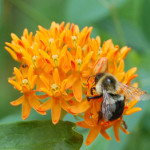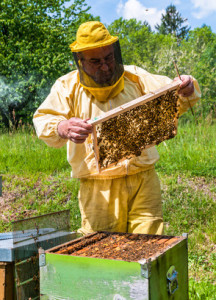 Where bees thrive they provide important services to plants and give a sense of hope for all those who care about achieving a sustainable future. Reports of losses in commercial honey bee colonies and reduced numbers of wild bee populations are of great concern.[1]
Where bees thrive they provide important services to plants and give a sense of hope for all those who care about achieving a sustainable future. Reports of losses in commercial honey bee colonies and reduced numbers of wild bee populations are of great concern.[1]
As a friend of RCLA, you probably know to avoid use of neonicotinoid insecticides in order to protect bees “Neonicotinoids, Pollinators and Alternatives”. Now we seek your help to further protect bees by avoiding use of the widely-sold herbicide, 2,4-D. It may be present in pesticide mixtures so you have to check ingredient lists of any products you are considering for purchase.
• • •
The absence of 2,4-D on the Carson House grounds and in organic gardens around the region, allows broad-leaf plants like these Chrysanthemums to stay vibrant and functional until late in the year, continuing to serve bees as they venture forth.
In 2015, Montgomery County, MD passed a law (based on Bill 52-14) restricting use of certain hazardous pesticides on lawns when applied for cosmetic purposes. Among these chemicals is the widely-sold herbicide 2,4-D (used for its power to kill broad-leaf plants). 2,4-D was also one half of the Vietnam era military weapon Agent Orange.[2]
Montgomery County’s newly-passed 52-14 based law will not be implemented until 2017. However, we encourage citizens in the county and elsewhere to avoid using 2,4-D, effective immediately.
A lawn free of hazardous pesticides including 2,4-D can preserve the pollinator services provided by broad-leaf plants growing nearby, such as the Dendranthema Chrysanthemums mentioned above as well as dandelions and clovers that are also beneficial to bees. Avoiding 2,4-D could prevent a little known, potentially harmful direct effect on bee heart muscle, as described in the Summary below.
SUMMARY: The health of people, pets, and wildlife, as well as of bees and broad leaf plants may be adversely impacted by 2,4-D
2,4-D is a volatile chemical noted for drifting from its application site and can be especially damaging to sensitive, desirable plants.
Plants
The herbicidal (lethal) action of 2,4-D on broad-leaf plants resembles poisoning with excessive growth hormone. Non-lethal effects on plants can include changes in plant toxicity and palatability. Some non-broad-leaf plants such as corn may be adversely affected by 2,4-D exposure. 2,4-D has been associated with increased numbers of pests and disease organisms in corn plants.
 Two important crops/ garden plants, tomatoes and grapes are extremely sensitive to damage from 2,4-D.
Two important crops/ garden plants, tomatoes and grapes are extremely sensitive to damage from 2,4-D.
Commercial farmers have strenuously objected to recently proposed increases in 2,4-D product registrations.
Humans, Pets, Laboratory Animals
2,4-D and/or herbicidal products containing it have been linked in people, pets and/or laboratory animals, to skin problems, neuromuscular problems, gastro-intestinal, liver and kidney difficulties, as well as to cancer.
In laboratory animals 2,4-D has been associated with teratogenicity and embryotoxicity, as well as adverse effects on immune function and developmental behavior. These findings may have relevance for human health.
Wildlife
 2,4-D comes in a wide range of forms and is present in a wide range of marketed products. In addition there are variations in the responses of wild species to these products. As a result the direct toxicity for wildlife of 2,4-D can vary. 2,4-D toxicity ranges from low to high for: fish, aquatic invertebrates, crustaceans, and certain insects. For birds 2,4-D’s toxicity ranges from low to moderate. Bird and frog egg development may be inhibited by 2,4-D.
2,4-D comes in a wide range of forms and is present in a wide range of marketed products. In addition there are variations in the responses of wild species to these products. As a result the direct toxicity for wildlife of 2,4-D can vary. 2,4-D toxicity ranges from low to high for: fish, aquatic invertebrates, crustaceans, and certain insects. For birds 2,4-D’s toxicity ranges from low to moderate. Bird and frog egg development may be inhibited by 2,4-D.
In honey bees, 2,4-D was found to inhibit heart contractions. 2,4-D was the only herbicide linked to bee kills (in observations by apiaries from 2005).
Exposure to 2,4-D can generate unintended impacts on wildlife food chains.
(Details and references for the above are available below at “25 REASONS…”)
LATE-BREAKING NEWS
On November 24, 2015 the USEPA announced it was revoking the registration of the 2,4-D-containing herbicide, Enlist Duo™. This product, a combination of glyphosate (aka Roundup™) and 2,4-D, had been granted registration status by USEPA for 15 states during 2014-15. A key factor in the status change for Enlist Duo™ was the discovery of information in a patent application indicating that the combination was synergistic (more toxic than the sum of the two herbicides’ toxic effects). USEA’s initial registration of Enlist Duo™ was based on information indicating that the two herbicides were not synergistic. (Pollack, A., “EPA revokes approval of herbicide for gene-altered crops,” The NYT, 11-26-15) The new information means that Enlist Duo™ could be more toxic to non-target organisms than previously believed by the USEPA.
An earlier observation found 100% lethality in a non-target, grain beetle (a preferred food of farmland bird species) exposed to a combination of the herbicides 2,4-D and glyphosate at rates actually applied to crop land by farmers. (Castilla, A., et al, Environ Contam Toxicol, (2010) 84, 101-105)
These findings have implications for multiple simultaneous uses and effects of cross contamination conditions on humans, pets and wildlife food chains exposed to 2,4-D, glyphosate as well as other pesticides.
25 REASONS TO AVOID 2,4-D – CONTAINING PESTICIDE PRODUCTS
#1) Volatility:
2,4-D is a volatile chemical noted for drifting from its application site, and can be especially damaging to sensitive, desirable plants. (The Maryland Master Gardener Handbook, 4th edition, 19-9, 2004)
#2) Unanticipated Hazards of Pesticide Formulations:
There is inadequate hazard testing of pesticide product formulations that are available on the market, and product toxicity can vary with different 2,4-D salts and various formulations (Kamrin, M.A., (ed), Pesticide Profiles, CRC Press 1997). A 2014 scientific study found that compared to active ingredients alone certain pesticide products as marketed could be up to 1,000 times more toxic to human cells (Mesnage, R., et al, “Major pesticides are more toxic to human cells than their declared active principles,” BioMed Research International, V. 2014, article ID 179691, 8 pages). With different 2,4-D salts and various product formulations some pesticide products could be more hazardous than single chemical pesticide active ingredients. Current methods for assessing health hazards of pesticides (a single active ingredient at a time) could fail to identify such problems and make formulated products appear less dangerous than they truly are. The recent, Enlist Duo™ decision by USEPA raises questions about greater hazards of pesticide products due to possible synergistic effects of 2,4-D when combined with other herbicides. (See LATE BREAKING NEWS, above.)
#3) 2,4-D has been linked to nerve problems:
For 2,4-D’s toxic effects on nervous tissue (peripheral nerves and the brain) from laboratory studies and adverse reaction reports, see #15, #16, #17, #19.
#4) 2,4-D has been linked to muscle weakness, muscle stiffness and incoordination:
For 2,4-D’s toxicity to muscles, see #16, #17, #20.
#5) Biochemical changes in the blood of patients poisoned by 2,4-D have indicated liver cell injury, (Reigart & Roberts, Recognition and Management of Pesticide Poisonings, 5th edition, USEPA)
For 2,4-D’s toxicity for liver tissue see (Tuschl, H., & C. Schwab, “Cytotoxic effects of the herbicide 2,4-D in HepG2 cells” Food and Chemical Toxicology, 41 (2003) 385-393)
#6) Some patients poisoned by 2,4-D have developed life-threatening kidney failure. (Reigart & Roberts, Recognition and Management of Pesticide Poisonings, 5th edition, USEPA)
For 2,4-D’s toxicity for kidney tissue, see #17.
#7) 2,4-D’s intracellular mechanisms of damage: 2,4-D has been found to impact a number of different components of the mammalian cell including inhibition of microtubules, (Russo, et al, “2,4-D disrupts the cytoskeleton and disorganizes the golgi apparatus of cultured neurons,” Toxicol. Sciences, 56, 133-140, 2000)
2,4-D may damage cells by increased production of intracellular reactive oxygen radicals (Zeljezic, D., et al, “Chromosomal aberrations, micronuclei and nuclear buds induced in human lymphocytes by 2,4-D pesticide formulation,” Toxicology 200 (2004) 39-47)
#8) 2,4-D has been linked to multiple effects on immune functions: 2,4-D harms organs involved with the immune response (thymus and spleen) (Kaioumova, D., et al, “Toxic effects of the herbicide 2,4-D on lymphoid organs of the rat,” Chemosphere, v 43, #4-7, May-Jun, 2001, pp 801-5)
#9) 2,4-D has been linked to non-Hodgkin Lymphoma in people (Hoar, S., et al, 1986, “Agricultural herbicide use and risk of lymphoma and soft- tissue sarcoma, “ J. of Amer. Med. Assoc., 256:1141-1147)
#10) 2,4-D has been linked to canine malignant lymphoma in dogs (Hayes, et al, “Case control study of canine malignant lymphoma: positive association with dog owner’s use of 2,4-D acid herbicides,” J. Natl Cancer Inst., 83, 1991)
#11) 2,4-D causes brain tumors (astrocytomas) in mice (USEPA Carcinogenic Potential List, 8-31-2000)
#12) 2,4-D was classified by the World Health Organization’s IARC in 2015 as a possible human carcinogen (World Health Organization/International Agency for Research on Cancer (IARC), IARC Monograph evaluating 2,4-D, June 23, 2015)
#13) 2,4-D has been linked to gonadal tumors in shellfish (Micic, M., et al, “Influence of herbicide 2,4-D, on haemocyte DNA of in vivo treated mussel,” J. of Experimental Marine Biology and Ecology, 311 (2004) 157-169)
#14) In rodents, 2,4-D exposure causes a variety of developmental behavioral deficits, motor abnormalities and changes in the brain.
The chemical has been found to interact with specific parts of the developing brain. Certain effects seem to be reversible if treatment with the herbicide is interrupted. (Bortolozzi, A., et al, “Effects of 2,4-dichlorophenoxyacetic acid exposure on dopamine D2-like receptors in rat brain,” Neurotoxicology and Teratology, 26 (2004) 599-605)
Exposure during pregnancy and lactation to 2,4-D produced a permanent alteration in the serotoninergic system in the developing rat brain. There was a 5-HT neurotransmitter increase in the hippocampus. Evidence of a functional interaction between 5-HT and astroglia cells [cells in the brain] was documented. (Garcia, G., et al, “Morphological study of 5-HT neurons and astroglial cells on brain of adult rats perinatal or chronically exposed to 2,4-dichlorophenoxyacetic acid,” NeuroToxicology, 22, (2001), 733-741)
#15) In some formulations, 2,4-D may cause serious eye damage and skin irritation. Skin exposure to 2,4-D may affect the nervous tissue. (2,4-D Pesticide Fact Sheet-US Forest Service 1995)
#16) Exposures to 2,4-D containing pesticide products have resulted in adverse effects in people.
“In humans, prolonged breathing of 2,4-D causes coughing, burning, dizziness and temporary loss of muscle coordination. Other symptoms of poisoning can be fatigue and weakness, with possible nausea.” (Kamrin, M.A., (ed), Pesticide Profiles, CRC Press 1997)
The dermal [skin] exposure to prepared for use [ready to use] formulations of 2,4-D resulted in early fatigue, anorexia, nausea, vomiting progressing within a week through peripheral paresthesia [abnormal sensations] in the fingers and toes, severe muscle pains and inability to walk because of muscle weakness, and advancing to a sensory deficit to pain, touch and heat in both hands and feet, a flaccid quadriparesis [incomplete paralysis of all four limbs] more severe in the lower extremities, with slow improvement over a 12 month period.” (Ecobichon & Joy, Pesticides and Neurological Disease, 2nd ed, 1994, p. 357)
Accidental exposure to 2,4-D has been linked to a “slow developing, persistent neuropathy” [nerve problem]. (Ecobichon & Joy, Pesticides and Neurological Disease, 2nd ed, 1994, p. 357)
#17) Exposures to 2,4-D containing pesticide products have resulted in adverse reactions in dogs.
Initial signs of poisoning are most commonly vomiting, nausea, depression or skin or eye irritation. The 2,4-D poisoned dog can also develop mouth ulceration. There are no known antidotes for phenoxy herbicide poisoning. Treatment should emphasize decontamination. (Osweiler, et al, Clinical Companion: Small Animal Toxicology, Wiley-Blackwell, 2011)
Phenoxy herbicides, including 2,4-D can adversely affect the canine muscle system resulting in rigidity [myotonia] and or rear leg weakness. (Osweiler, et al, Clinical and Diagnostic Veterinary Toxicology, 3rd edition, 1985)
A pet dog developed terminal kidney failure after being exposed to a lawn freshly treated with a combination of 2,4-D and 2 related herbicides. (Missanelli, M.G., “Death of a pet, and chemicals used on lawns,” The Philadelphia Inquirer, Oct. 6, 1986) After death the dog’s kidney tissue showed measurable levels of all 3 herbicides.
#18) Dogs have a 10-20 fold lower capacity to eliminate 2,4-D from their bodies than do rodents.
Scientific data reflects that dogs have greater sensitivity to 2,4-D than do rodents (laboratory animals used to estimate toxicity for humans). (Van Ravenzwaay, et al, “Comparative metabolism of 2,4-D in rat and dog,” Xenobiotica, August 2003, v 33, # 8, 805-821)
#19) 2,4-D can be hazardous to wildlife.
Due to different forms of 2,4-D in products and variations in marketed formulations, the herbicide’s direct toxicity for wildlife varies from low to high for fish, aquatic invertebrates, crustaceans, and certain insects. For birds direct toxicity varies from low to moderate. (2,4-D Pesticide Fact Sheet, USEPA 1989) For birds and frogs, egg development may be inhibited by 2,4-D. Significant reductions in populations of crustaceans and molluscs have been linked to 2,4-D. (Briggs, S, Basic Guide to Pesticides, 1992) The fatality rate was 100% for adult grain beetles, Tenebrio molitor exposed to a mixture of glyphosate and 2,4-D applied to crop land. (Castilla, A., et al, “Nitrates and herbicides cause higher mortality than the traditional organic fertilizers on the grain beetle, Tenebrio molitor,” Environ Contam Toxicol, (2010) 84, 101-105)
Bird populations that depend on a variety of plants for seeds, shelter and for insects to feed their young can be harmed by herbicide-related reductions in plant biodiversity in natural areas. (Sotherton & Holland, “Indirect effects of pesticides on farmland wildlife,” in Handbook of Ecotoxicology, 2nd ed, 2002)
#20) In honey bees: Both the force and the frequency of the spontaneous heart contractions under isolated heart conditions were inhibited in a dose-dependent manner by 2,4-D.
The honey bee heart was found to be more sensitive to 2,4-D than the heart of the beetle and the frog. (Papaefthimiou, C., et al, “The action of 2,4-D on the isolated heart of insect and amphibian,” Environmental Tox and Pharm, 11,(2002) 127-140) The implication of this finding is that 2,4-D may cause a malfunctioning heart, but not heart failure that would kill a bee. With a malfunctioning heart a honeybee “would definitely have problems and die during flying where the full power of the heart is required.” (Papaefthimiou, C., et al, “The action of 2,4-D on the isolated heart of insect and amphibian,” Environmental Tox and Pharm, 11,(2002) 127-140)
In a 2005 survey of bee kill observations reported by apiaries, 2,4-D was listed. It was the only herbicide on the list.
#21) 2,4-D can produce different adverse/unexpected effects on the toxicity of various plant species: (A) Plants may build up dangerous levels of nitrates (joe pye weed) or cyanide prior to death, and thus present a hazard to herbivores. (B) Also, toxic weeds may become more palatable (wild cherry) and more likely to be consumed by herbivores although still dangerous. (Osweiler, et al, Clinical and Diagnostic Veterinary Toxicology, 3rd edition, 1985) Corn plants exposed to 2,4-D (corn is not a broad leaf plant sensitive to 2,4-D) showed greater numbers of aphid and borer pests as well as higher levels of leaf blight than did the unexposed corn plants. (Pimentel & Oka, “Herbicide (2,4-D) increases insect and pathogen pests on corn,” Science, v 193, July 1976)
#22) A US farmers’ coalition expressed opposition to new GMO plants with the gene for resistance to 2,4-D, due to fear that increasing use of 2,4-D on neighboring farms would damage their crops. (Pollack, A., “Environmental review to delay two engineered crops, “The NYT, 5-10-13)
An organic farmer in Mississippi claimed that drift of 2,4-D wiped out his crop worth $40,000. The chemical’s source was linked to nearby lawn applications. (Pesticide & Chemical Policy, 5-17-13)
#23) In Kansas, 2,4-D has been called, “a dangerous instrumentality” and handling it “a hazardous activity.” (Feistans, T., “State Pesticide Drift Laws”)
#24) “Volatile herbicides, like 2,4-D should not be used near highly sensitive plants like grapes and tomatoes.” (The Maryland Master Gardener Handbook, 4th edition, 2004, p. 19-9)
#25) The most recent (2005) USEPA Registration Eligibility Document (RED) for 2,4-D recommends additional studies pertaining to human health as needed:
This indicates that the research required by USEPA for evaluating the adverse impacts to humans of 2,4-D was incomplete as of 2005. Depending on the requested tests’ results, USEPA may change the recommendations for human exposure to 2,4-D.
Please Note: The number of reasons to avoid 2,4-D does not end with this list. This represents a sampling of effects linked to this chemical. There remains a need for further research on 2,4-D’s toxicity.
Prepared by Dr. Diana Post with Munro Meyersburg, December 8, 2015.
FOOTNOTES
[1] In a recent Letter to the American Bee Journal, a beekeeper reported “losing 2 of my 3 hives last summer [after] a lawn chemical company treated the lawn for weeds every 2-3 weeks [and] the bees…[gathered] that tainted water from the puddles left daily after lawn irrigation.” The hive that survived “may have been watering at our bird feeder.”
Deeply troubled by loss of the honey bees, this beekeeper reported his observations to the USEPA at beekill.epa.gov, and strongly urged fellow beekeepers to do so if they notice a similar “coincidence” with their hives.
We cannot be absolutely certain if and/or how the herbicide product applied to this writer’s turf contributed to the unfortunate hive losses. However, we note that a 2005 survey of apiaries found one of the chemicals reported as associated with bee kills was the herbicide 2,4-D. We also note that 2,4-D is a widely-sold herbicide for use on lawns and has been found to adversely affect the honey bee heart muscle at low levels.
[2] Agent Orange (2,4-D & 2,4,5-T) was widely sprayed by the US military as an ecocide in Vietnam(from 1961 to 1971). Under the “Operation Ranch Hand” program, Agent Orange decimated forested areas throughout that country.


